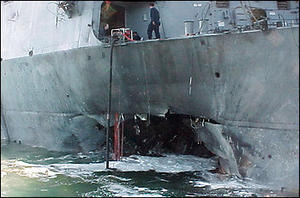USS Cole: 10 years onCole's legacy: a different U.S. Navy
The terrorist bomb attack on the destroyer Cole on 12 October 2000 was a watershed moment in modern Navy history; it was also a wake-up call on the need for better force protection, damage-control training, intelligence sharing, shipboard equipment, and mass-casualty response

Waterline damage to the Cole after the attack of 2000 // Source: whereistheoutrage.net
The terrorist bomb attack on the destroyer Cole on 12 October 2000 was a watershed moment in modern Navy history. It was also a wake-up call on the need for better force protection, damage-control training, intelligence sharing, shipboard equipment, and mass-casualty response.
Significant strides forward in these elements have been made in the past ten years, officials say — some of the steps prompted by changes mandated in the Pentagon’s 2001 Cole Commission Report, others by debriefs and after-action reports.
William H. McMichael writes in Navy Times that no area has advanced more than force protection, both in port and in transit. He quotes Capt. Sam McCormick, the anti-terrorism/force protection officer for Fleet Forces Command to say that “There’s been a huge amount of change.”
Doctrine, organization, materiel, logistics, facilities and personnel requirements have been modified and training has been “totally revamped,” McCormick said. Afloat training groups train ships’ reaction forces in basic and advanced techniques, and train their trainers as well. Ships cannot deploy without passing strike force certification training on anti-terrorism force protection, or ATFP.
Ships in port employ protective zones, security barriers and harbor security patrols. High-value units are escorted in and out of port, often by the Coast Guard, which has law enforcement capability. Gate sentries get specialized training. The master-at-arms force has increased fivefold since 2001.
In addition, the rules of engagement around the world have “been thoroughly reviewed and amended as appropriate,” McCormick said. The standing rules are defined by the Joint Staff. In high-threat areas such as 5th Fleet, he said, those rules are modified by the combatant commander, who has sole responsibility for setting the threat level in his area.
Ship commanders formerly had wide latitude in how they handled ATFP but set their own force protection postures based on the threat level, he said. Cmdr. Amy Derrick-Frost, 5th Fleet spokeswoman, said commanders also coordinate extensively with host nation officials and U.S. Embassy country team officials and consider active intelligence and current threat assessments.
“One of the biggest pieces that came out of the attack on the Cole was truly a mindset change in the Navy,” McCormick said. “When you have a successful attack in which, tragically, 17 sailors were killed and a billion-dollar warship was significantly damaged, that changes the psyche of the Navy.”
When ship crews arrive in theater, he said, “They are leaning forward in their boots, they are vigilant to the extreme. Everything is possible. And
